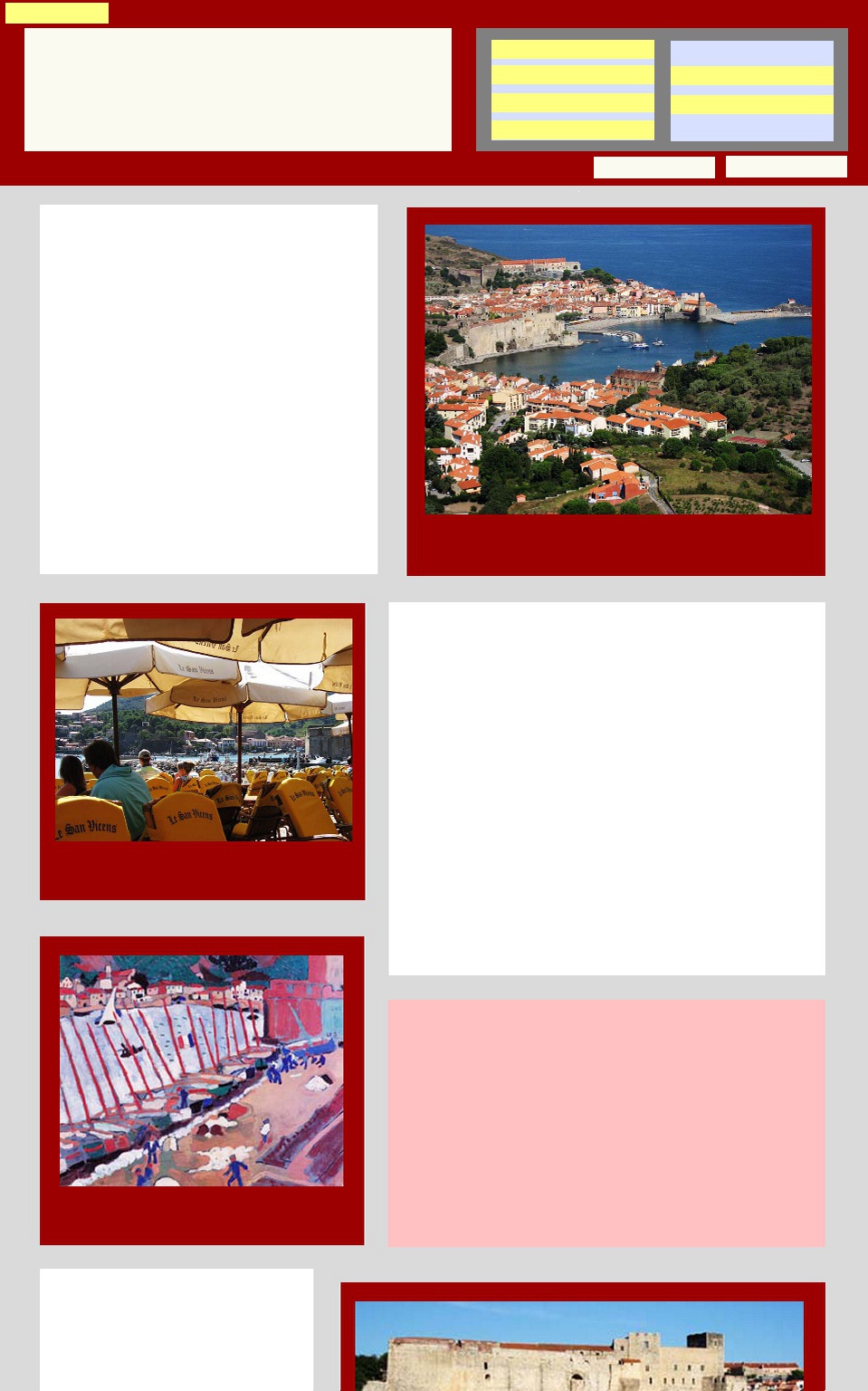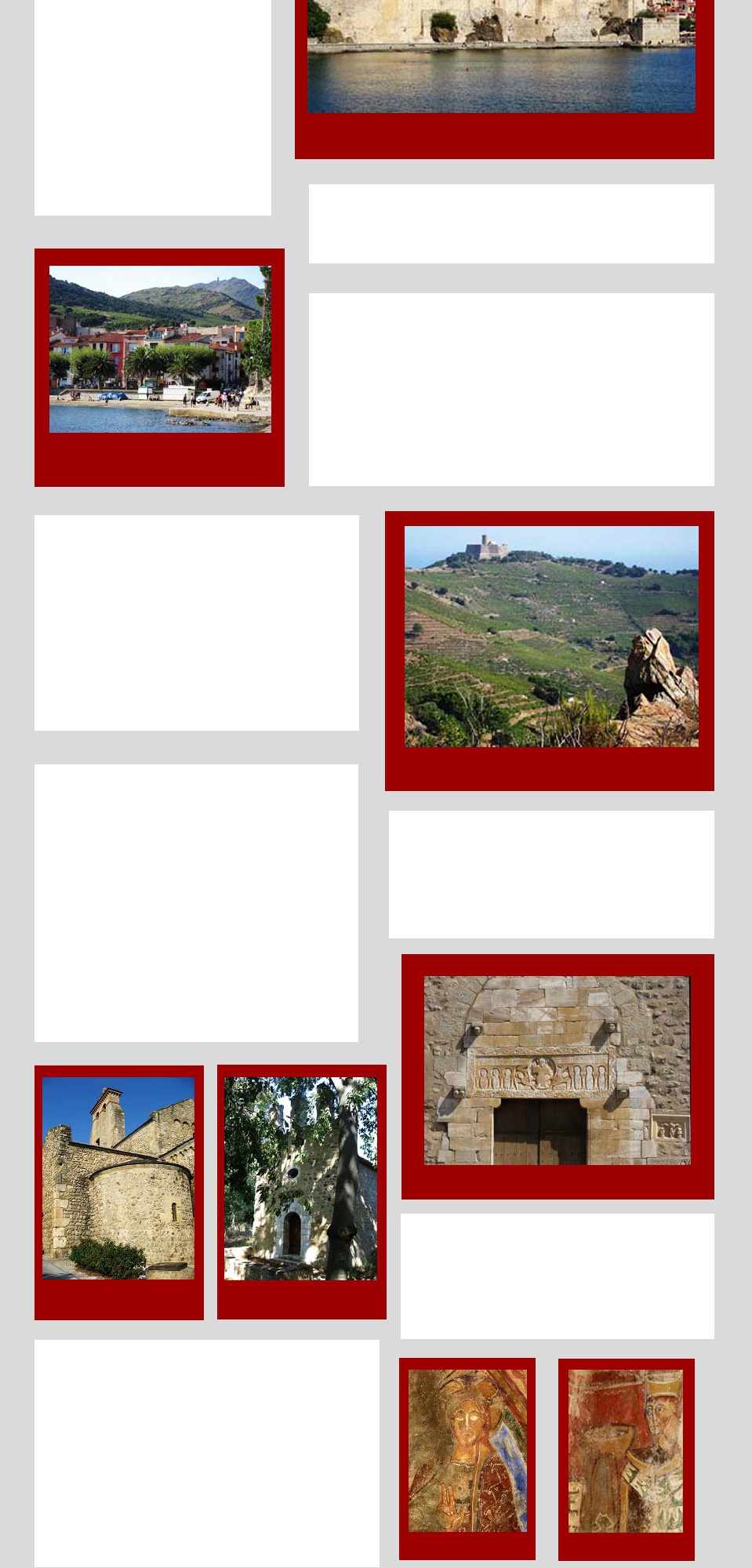


Collioure and
the Côte Vermeille
La Côte Vermeille
The "vermilion coast" is a region on the Mediterranean
coast near the border with Spain. It stretches from the
town of Argèles-sur-Mer to the border village of Cerbère.
The towns of Collioure, Port-Vendres and
Banyuls-sur-Mer are nestled along a 20 km stretch of
beaches, small bays, creeks and coves, with some
fabulous walks and trails. Although busy with tourists in
the summer it is also where the French spend their
holidays.
In some places here, the Pyrenées virtually tumble
down into the sea. The steep slopes rising up from the
ocean are terraced into hillside after hillside of
vineyards - le Côte de Banyuls. Some vineyards appear
to be newly planted, others are very old with rows of
ancient vines still being harvested, while some terraces
have been completely abandoned. They have been
growing grapes here for centuries, using techniques
developed by the Templiers.
Collioure
Collioure is the colourful port town immortalised in the paintings by
the fauve school of painters, Matisse and his followers, who from
around 1905 made this their home. Later Picasso was to join them.
You can do a walk around all the sites which appear in their
paintings.
The port is, in effect, two ports in a semi circular bay with a huge
fortified chateau separating them. The chateau is called the Château
Royal and it dates from the 13th century when it was built by the
Knights Templar to ward off Saracen pirates. It is everything a
crusader castle should be - parapets, towers, staircases climbing
round the walls and heavy stone ramparts with slits and holes for
shooting arrows through.
It's not hard to see why Collioure became so favoured by the painters
whose trademark was the use of strong bright colour - the brilliant
skies, the bright clear water, the fishing boats and the deck chairs
around the many cafes all scream out "paint me". This is why there are
still so many artists studios here and why painters successfully peddle
their work in the narrow streets of the old town.
Fauvism
Fauvism was a short-lived, but highly influential, avant garde art
movement founded in 1905 by Henri Matisse in Collioure.
The artists were dubbed fauves or wild beasts because of the wild bright colours they used and the distorted shapes in their vibrant, cheerful and vigorous works which fully embraced the colourful and vivacious atmosphere of the Mediterranean coast.
The artists were dubbed fauves or wild beasts because of the wild bright colours they used and the distorted shapes in their vibrant, cheerful and vigorous works which fully embraced the colourful and vivacious atmosphere of the Mediterranean coast.
Matisse led the group which also included Derain, Dufy, Vlaminck, van
Dongen, Manguin and Braque. Matisse would continue to use vibrant
colour, but the other painters moved towards cubism and German
expressionism which would both take totally different directions.
We have visited Collioure twice. The first
time was in1995 when, after leaving Evol up
in the shadow of Canigou, we dropped down
from the chain of the Pyrenées to the
Coast.
We stayed several nights in a hotel alongside
the fishing end of the port and could not
resist splurging on a room with a view across
to the castle. There were plenty of
restaurants selling delicious fresh seafood.
Anchovies and sardines are a local
speciality - they feature on all the restaurant
menus and are piled up on the stalls in the
colourful local market which is one of the
best you'll encounter in the south. Not
recommended is a dish of bulots one of us
ate one night. These were tiny little shellfish
not much bigger than periwinkles piled up in
a dish with a sauce of wine and garlic which
was the only saving grace
The magic of Collioure had stayed with us over the years, so in 2009 we
rented an apartment for a week to do some more walking and to indulge in the
local wine and seafood. The apartment was tiny but it had a wonderful terrace
where we sat in the evenings looking over the town and the twinkling lights of
the port.
Walking
Just south of Collioure on the Mediterranean coast is Banyuls-sur-Mer where
the GR 10 finishes its long journey across the Pyrenées. You can join the GR
10 on the heights above the sea and follow it down through the vines to
Banyuls. You can pretend this is your final stage on the GR 10, but the real
achievers will probably look rather more travel weary.
There are many other walks up in the hinterland and linking Collioure to
Banyuls and Port Vendres. An energetic option climbs up from Collioure to the
15th century Tour Madeloc at 656m , then descends to the Col des Gascons
and joins the GR10.
There is also a great walk south to Banyuls sur Mer along
a coastal pathway once used by smugglers and the
customs men who pursued them, passing by Port Vendres
and the Cap Bear, sometimes skirting around small creeks
but always with wonderful sea views. This walk continues
across the border into Spanish Catalonia, and on to Port
Ligat and Cadaqués.
A very efficient shuttle bus runs up and down the coast
between the towns, so you easily find your way home after a
walk. It is also great for exploring the coast and visiting the
other towns, jumping on and off along the route and avoiding
the horrendous traffic jams that clog the coast in summer.
Romanesque Churches
During our exploration of the area we also discovered a
treasure trove of small Romanesque churches. Having long
been enthusiasts of this 11th and 12th century style of
architecture, this was an added bonus.
In the flat coastal plains north of Collioure we found two
splendid examples. First was Saint Genis des Fontaines
which has a carved marble lintel over its west door, dated
1019-20. This makes it one of the earliest Romanesque
sculptures in France and it is superbly carved in a charming
naive style . It was probably a feature of the buildings of a
monastery that had existed on the site from the 9th century
and placed in its present position when the church was
rebuilt around 1153. A cloister, built in the 13th century has
strange and intriguing animals carved on the capitals of the
columns that surround the cloister.
There is a similar lintel in the nearby St-André-de-Sorède but,
while this one may have been technically better, it seemed to
be less well integrated into the old stones of the church.
Again, there was an abbey here in the 9th century. We were
unable to look inside the buildings as we were there on a
Saturday and it was a popular place for weddings which
seemed to follow each other with unseemly haste.
Not far away, in a forest clearing, was the abandoned
small Chapelle Sainte Colomba de Cabanes. Although
largely a ruin and closed to the public, it is reasonably
well maintained and showed signs of some ongoing
restoration work. Built in the 11th century by the monks of
St André, it was declared to be the property of the state
during the revolution and is now maintained by the mairie
of St Genis.
The real gem in this collection of churches was Saint Martin de
Fenollar, a pre-Romanesque chapel dating from 844, which survives
today in an island between the busy roads that lead up to the
Spanish border. During the early 12th century it was painted with
the frescos that are now considered to be the most important
assembly of Romanesque wall paintings in Roussillon.
They are very damaged but that they have survived at all is
remarkable, with road construction all around and a period when
the building was ingloriously used for agricultural purposes. We
were able to view the paintings as part of a group but only for a
very limited time, nevertheless time enough to fully appreciate
the pastel, earthy colours of these beautifully expressive naive
style paintings.
Return to Top
View pictures from
The town of Collioure
Café on the Port
Derain's impression of Collioure
le Château Royal dominating the port
The Pyrenées come down to the Mediterranean
Lintel at Saint Genis des Fontaines
St-André-de-Sorède
Chapelle Sainte Colomba
des Cabanes
le Christ en Majesté
l'un des Rois mages
Vineyards in the hinterland
Explore more FRANCE
Visit ITALY
Visit SPAIN/PORTUGAL
Explore on MAPS
Return to HOME PAGE
Explore PHOTO GALLERIES